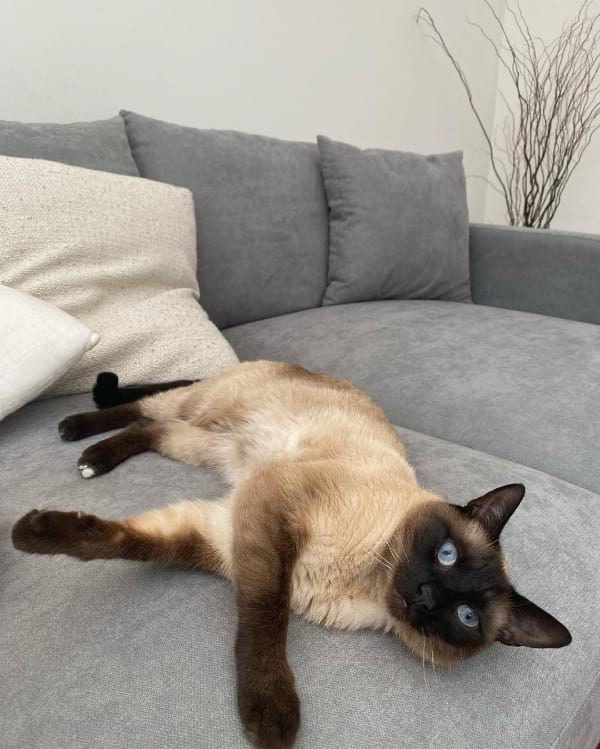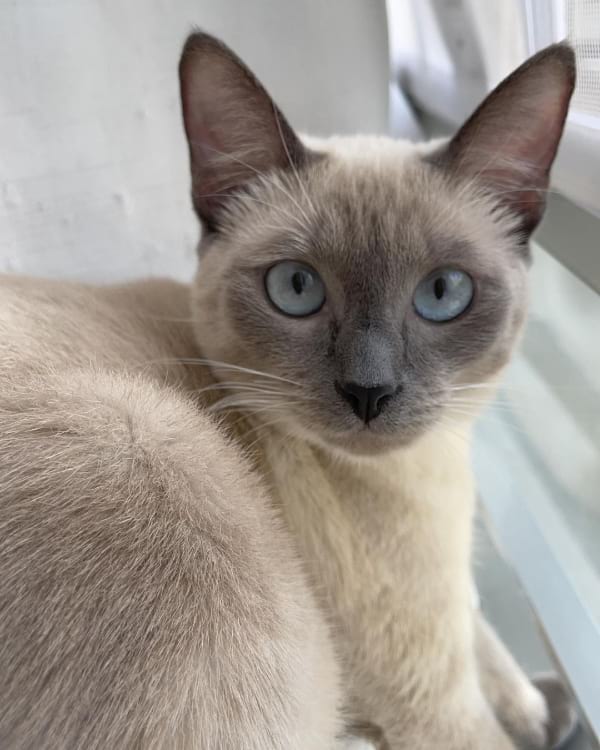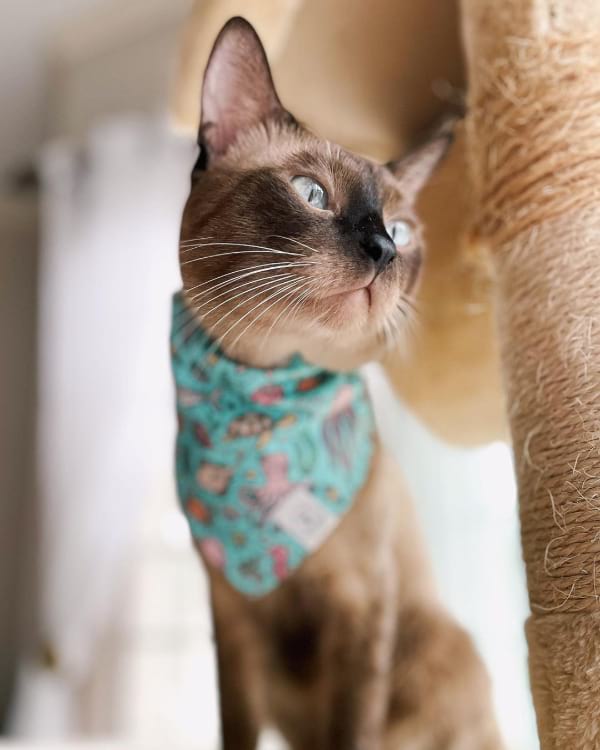Almost every second American family has a pet at home. The same statistics about domestic animal lovers are observed in other countries. About 80% of worldwide households adopt cats or dogs to have a pet companion and faithful friend children love and play with.
But the sharp question of allergy disturbs many families at the same time. More and more potential cat owners are searching for allergy-free breeds. Low-allergy cats and dogs are the best way to steer clear of allergens and perverse effects on their health. According to the NCBI statistics, about 10-20% of the global population suffer from allergies to pets.
Public concerns grow day by day together with the openness of people to have the most hypoallergenic cats and dogs. One of the excellent candidates to become a low-allergy pet companion is a Siamese. Both he-cats and she-cats are notable with their hypoallergenic background. According to the minimal owners’ allergic reaction issues to their shedding fur, these feline buddies crowd the top of the breed list.
But are Siamese cats hypoallergenic in fact? This is an iconic breed with an extremely attractive appearance and exceptional personality features.
There are plenty of Siamese cat lovers around the world. If the independent temperament and smartness are not a secret in the context of these gorgeous feline buddies with blue eyes and silky coats, the hypoallergenicity question stays open. Let’s dive into this topic together to get to the truth of the matter.
What Are Hypoallergenic Cat Pets?
It is worth noting that there is no 100% hypoallergenic cat breed in the world. But some of them really cause only mild or moderate allergic reactions even in the period of active shedding. Siamese feline buddies are the ones that do not trigger severe cat allergies.
Pet owners usually do well without any health issues. So, the Siamese breed is notable for its low-allergen cats.
Let’s take a closer look at the hypoallergenicity issue to understand what cats are hypoallergenic totally or to dispel this myth.
What Causes Cat Allergies?
The core factor that matters when it comes to cat allergy reactions is the special protein. The bigger its concentration is, the fewer chances to live with the low-allergen feline buddy under one roof. This protein is called Fel D1. And it is worth describing the special macronutrient and its effect in detail.
The Fel D1 Protein
This is the macronutrient that is presented in the organism of each pet cat. This is the most common misconception that these specific molecules can be found only on the feline fur. Besides the cat’s hair, the Fel D1 protein is in the cat’s urine, cat’s skin, and saliva. Proper cleaning of a litter box is essential to decrease allergic responses according to veterinary advice.
The breeds that have a high-level amount of this micronutrient are the worst cats for allergies. At the same time, Siamese felines obtain minor Fel D1 protein in the organism, so they are considered low-allergen pet companions.
Common Symptoms Of Allergy on Cats
The following are typical signs of an allergic response:
- Stuffy nose
- Moist eyes
- Sneezing
- Throat inflammation
- Skin irritation
Are Siamese Cats Hypoallergenic?
In general, these cats are good for allergies. It can be explained by the less specific protein production in Siamese organisms and their moderate shedding. Nevertheless, this breed as any other one cannot be called purely hypoallergenic. Siamese should be named as low-allergen cats together with other felines like:
- Oriental cats;
- Rex cats;
- Sphynx cats;
- Siberians;
- Balinese cats, other cats.
If the Rex and Sphynx males and females hit the list of the most hypoallergenic pets due to their coat (fur-free or short-haired), Siberians and Balinese buddies are almost non-shedding cats. Siamese is also not a heavy shedder. The fewer hair the feline leaves on different surfaces at home, the higher its hypoallergenicity is.
To sum up, Siamese is one of the great types of hypoallergenic cats. Their shedding is far from long-term while the hair obtains a decreased amount of Fel D1 protein.
Note that the critical aspect is the owner’s sensitivity. Sometimes even the most non-sensitizing cat breeds like Siamese-Sphynx mix or Devon Rex-Siamese mix can cause an allergic reaction (pet allergies) of different complexity.
Editor’s Note
Do Siamese cats cause severe allergic reactions?
Siamese cats don’t generate significant levels of the Fel d1 protein; as a result, allergy patients may experience lower responses to these cats.
Hypoallergenic Qualities in Cats
Besides the Siamese cat shedding factor and the reduced production of the Fel D1 protein, there is a range of other qualities to take into account. For example, the difference between males and females, the feline age, the animal hair length can affect allergic symptoms. These and other qualities characterize a truly hypoallergenic cat breed as Siamese.
Long-Haired
Some people who love cats are afraid to adopt long-haired breed representatives and give the preference to felines with shorter hair. But this aspect plays a minor role when it comes to allergy sufferers. The important factor is the pet companion’s shedding. Sometimes even the fluffiest buddies are considered allergy-friendly in comparison with the short-haired ones that loose hairs with allergen heavily.
That is why it is recommended for cat lovers with feline allergies to pay attention to low-shedding breeds. They are completely hypoallergenic even with the long coat and silky lengthy hairs. Even such fluffy felines as Balinese or Siberian are considered low-allergen pets.
It is not surprising that the Siberian-Siamese mix and the mix of Siamese with Balinese hypoallergenic cat pets are excellent for highly allergic people. These breeds are considered hypoallergenic together with other long-haired felines cross-breeded with Siamese:
- Javanese cat (hypoallergenic cats) pets;
- Oriental cat (hypoallergenic) buddies;
- Himalayan (hypoallergenic) felines;
- Burmese cat (hypoallergenic) males and females.
Low Shedding
All the hypoallergenic cat breeds are notable for their low shedding. That is why this is the critical factor when it comes to picking sides with the most allergy-friendly feline. Siamese cats shed moderately that is optimal for people who would like to avoid any allergic reactions. Even long-haired males and females of this breed do not bring severe allergy symptoms due to their low-shedding properties.
Age and Gender
It is worth noting that kittens obtain a decreased amount of Fel D1, so small Siamese buddies provide fewer allergic reactions. Adult cats of this breed have more specific protein but it’s not enough to cause serious allergy-driven health issues. If you are the owner of the long-haired Siamese kitten, be ready for the cats’ groom and delicate care about cat hair to minimize feline allergen production of your adult cat.
Additionally, the sex of the Siamese also matters. For example, a female cat produces less Fel D1 than a male. If you are too sensitive to feline allergens, it is better to adopt a she-cat. A female Siamese cat can become an excellent pet companion for families with children.
Outdoor
The concentration of cat allergens increases if your feline buddy lives indoors. A good idea is to permit your pet to stay for a while outside. Even the open balcony or terrace is a good idea for a short walk outdoors. Siamese cats’ low shedding together with regular outdoor activities is about spreading the specific protein out of your house.
Editor’s Note
Cats That Are the Worst for Allergies
British Longhair, Maine Coon, and Persian cats are bad for people allergic to Siamese cats and other cats as well.
Are Siamese Cats Low-Shedding?
The owners of short-haired felines are often asked: “Do Siamese cats shed?”. Of course, they do. But this is the low-shedding breed. That is why it is considered hypoallergenic. The same story is about mixed cats where two allergy-friendly breeds are crossed (for example, Siamese-Russian Blue mix).
Additionally, the low-shedding properties of Siamese do not depend on their color patterns. Blue-point, snowshoe, seal-point buddies, and other pretty kitties will shed the same way if their cross-breeding takes place with allergy-friendly parents.
So, answering the question: “Are flame-point Siamese cats hypoallergenic?”, the response will be positive because the color pattern (or cat food, feline’s regimen) does not affect the production of cat allergen.
Other Quick Facts About Siamese Cats
These fluffy buddies are very playful and extremely loyal. Families with kids should not worry about the friendly approach of Siamese to children. Some owners even state that the behavior of felines of this breed has a dog-like behavior. It means that your fluffy buddies can even execute some commands and be totally obedient.
Note that in comparison with other cat breeds, Siamese extremely loves people’s attention. They are not as independent and stubborn as Disney cartoons show us. If you are going to adopt a Siamese cat, be ready to provide your small pet with much love, care, and ways for entertainment with you and your family members.
How to Deal with Cat Allergies?
First of all, each animal lover should understand the high-level responsibility for the pet he/she adopts. If you are allergic to cats’ hair, it is better to pay attention to allergy-friendly breeds. But are there hypoallergenic cats? 100% allergen-free felines are nonexistent for sure.
At the same time, there are pet cats with low-shedding properties. Additionally, there are hypoallergenic breeds with reduced amounts of allergens in the hair, urine, and saliva (Devon Rex, Siberian, Bengal, Russian Blue, Siamese, and other breeds).
To minimize cat allergens in the house, form the following habits:
- Vacuum all the surfaces your feline contacts with.
- Do the damp cleaning and air the room regularly.
- Arrange a cat-free zone in the house.
- Wash the clothes after playing with your cat pet.
- Change the air conditioner filters 3-4 times a year.
- Allow your cat to spend some time outdoors.
Frequently Asked Questions
Do Siamese Cats Have More Dangers?
This is a friendly hypoallergenic breed with plenty of positive features of characters and playful nature. Siamese cat pets are not aggressive and far from stubborn. These felines like to have fun with people, prefer an active lifestyle, and pay attention to owners.
Are Siamese Mixed Cat Pets Hypoallergenic?
Almost all the Siamese mixes bring extremely mild allergies. They are low-shedding cat pets with a little amount of allergens on the hair, urine, and saliva. For example, the Siamese domestic Shorthair mix has the same allergy-friendly properties as the pure Siamese. Crossbreeding with Siberian, Devon Rex, and other short-haired and long-haired breeds with a hypoallergenic background demonstrate the same results.
Are Siamese Cats Good for Allergies?
These are almost hypoallergenic pets, so adopting a Siamese kitten is a good idea for allergy sufferers. Most cats even of exotic color patterns are allergy-friendly. Take a closer look at the seal-point Siamese hypoallergenic feline or other attractive males and females. Still are asked the same question: “Are lynx-point, snow-shoe, blue-point Siamese cats hypoallergenic?”? The answer is YES.
Do Siamese Felines Have Sensitive Skin?
Yes and no at the same time. Skin sensitivity depends on the conditions the Siamese felines live in. Active bewhiskered outdoor walkers have a risk of the development of dermal diseases. Experts recommend applying special feline sunscreens to prevent different skin allergic reaction issues.
How Can Health Niggles Affect Shedding?
Two factors that might result in excessive shedding in Siamese cats are the following:
Siamese cats are prone to obsessive behavior, such as overgrooming, which can result in patchy hair loss. This condition is known as psychogenic cat alopecia. The main reasons are stress, psychological trauma, anxiety, and boredom. Antidepressants and lifestyle modifications are frequently part of the therapy.
Feline hyperesthesia syndrome, sometimes referred to as the twitch-skin syndrome, affects Siamese, Burmese, and Abyssinian cats more frequently than other cat breeds. They develop excessive biting, scratching, and licking due to their extraordinarily sensitive skin, which can result in open wounds. A number of factors include parasites, food intolerances, and allergies to environmental materials.
How Can Quality Cat Food Help Manage Cat Allergies?
A poor diet might make cats shed more and expose you to more allergens. You should provide your cat with high-quality food if you want to lessen shedding and prevent numerous skin-related problems. Small creatures like birds, mice, and slugs are what cats seek and consume in their natural environment, so the food you provide your cat should have enough protein, moderate levels of fat, and the required vitamins and minerals.
Final Word
So, are Siamese cats hypoallergenic? Together with Sphynx and oriental breeds, Siamese comes too close to being named hypoallergenic. These felines are notable for their low-shedding properties and less triggering allergic reactions. Siamese shed period is quite moderate in comparison with other cat breeds.
If you are searching for an allergy-friendly feline with an extremely attractive appearance and friendly behavior, be sure that these bewhiskered cuties will become a good pet companion for your family. Siamese felines are the best playmates for you and your children!
Additionally, adopting blue-eyed kitties of this cat breed with silky coats will not be complemented with a running nose and sniffling.
Table of Contents



